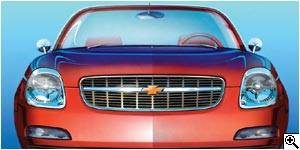History of the Bel Air Nameplate
This Bel Air Concept Vehicle was viewed at auto shows in 2002.
Drawing on the expressive flair of the original, this Bel Air concept vehicle revamped several
of the Bel Air design cues. Exterior features include a prominent egg-crate grille, distinctive headlamps and a gas filler cap hidden in the tail lamp.
Interior features included a simple yet elegant passenger compartment with twin-element instrument panel, steering column-mounted gearshift and bench seats.
Powered by an all-aluminum Vortec 3500 turbocharged in-line five-cylinder concept engine that delivers up to 315 horsepower and 315 lb.-ft. of torque, it was mated to a Hydra-matic 4L60-E electronically controlled four-speed automatic transmission.
But the real excitement comes at the push of button located on the steering wheel. It activates the powertrain control module to trigger a more aggressive spark and fuel calibration for maximum horsepower.
As a result, you can go from an efficient five-cylinder to a high performance powerhouse — all in the same package. This concept vehicle was never produced, but the Bel Air nameplate has a great history.
THE 1950–1954 CHEVY BEL AIR:
IT PUT THE “HARDTOP” IN THE DICTIONARY — AND THE DRIVEWAY.
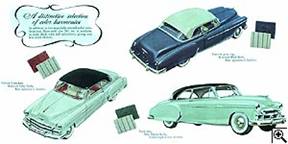 The very name conjures up images of movie stars, seaside mansions and lazy summer days. Inspired by the Cadillac Coupe de Ville, the 1950 Chevrolet Bel Air was America’s first low-priced “hardtop coupe.”
The very name conjures up images of movie stars, seaside mansions and lazy summer days. Inspired by the Cadillac Coupe de Ville, the 1950 Chevrolet Bel Air was America’s first low-priced “hardtop coupe.”
The exclusive-to-GM hardtop roofline combined the breezy pillarless style of a convertible with the security and solidity of a steel roof.
Suddenly, it was the 1950s, and the brand-new American dream included a modern split-level in the suburbs, TV dinners in the family room — and a new “hardtop” in the carport. This Chevy was the right car at just the right moment.
To be sure, the Bel Air’s success involved more than just a racy roofline. For just $1,741, Chevy came through with neat two-tone paint schemes and beautifully tailored interiors. A revolutionary option was the Powerglide automatic transmission, a Chevrolet first in a low-priced car. Mom loved it. Dad loved it. Junior wasn’t so sure.
After the big splash in 1950, changes to the Bel Air were minimal in 1951 and 1952. New sheet metal — with an even closer resemblance to the Cadillac — greeted Chevrolet fans in 1953 and the popular Bel Air nameplate was now affixed to an entire series of top-of-the-line Chevy hardtops, sedans and convertibles.
Power steering was a new option — and another Chevrolet first in the low-price class. Power brakes, power windows and a power driver’s seat were added to the option list in 1954. Could driving get any better than this?
Well, 1955 was just a year away, and the recently introduced Corvette sports car offered a hint of what Chevrolet was up to.
THE 1955 BEL AIR: FOREVER YOUNG.
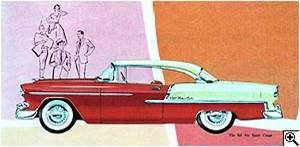 Anyone looking for the proverbial fountain of youth will find it in a ’55 Chevy. Make that a Bel Air Sport Coupe with a Power Packed Turbo-Fire V8 under the hood and a three-speed stick and you’ll be 16 again.
Anyone looking for the proverbial fountain of youth will find it in a ’55 Chevy. Make that a Bel Air Sport Coupe with a Power Packed Turbo-Fire V8 under the hood and a three-speed stick and you’ll be 16 again.
The moment that first ’55 Bel Air roared to life, one thing was certain … Chevy was no longer a Sunday morning kind of car. This one was a Saturday night cruising car.
Overnight, the jokes about Grandma’s six-cylinder Chevrolet stopped. Ed Cole’s artfully engineered new V8 engine made flathead Fords and low-ridin’ Mercs old news — the’55 Chevy V8 was “the hot one” on the track, on the turnpike, and in high school parking lots all across the land.
It wasn’t just the optional Turbo-Fire V8 that made the ’55 Bel Air every teenager’s dream ride. If ever a car looked new, this was it. Chief designer Harley Earl gave the hardtop Bel Air the low-down look of a “hungry hound dog.” The spectacularly simple styling borrowed from Cadillac, stole from Corvette, and ended up as nothing less than an American classic. The happy result? Chevy sales smashed all records, topping the 1.6 million mark for the first time.
And — best of all — that eager little V8 would one day be recognized as one of the most influential automotive engines of all time, with versions of it powering millions of Chevrolet cars, trucks, racing machines and street rods for decades to come.
BEL AIR FOR 1956: “THE HOT ONE’S EVEN HOTTER.”
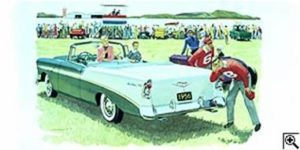 Chevy hit all the hot buttons for 1956 — with a bold new face-lift, a sharp new Bel Air four-door hardtop (the first in Chevy’s class), and even more powerful Turbo-Fire V8 options. Now there was no question about which nameplate had momentum — it was Chevy all the way in ’56.
Chevy hit all the hot buttons for 1956 — with a bold new face-lift, a sharp new Bel Air four-door hardtop (the first in Chevy’s class), and even more powerful Turbo-Fire V8 options. Now there was no question about which nameplate had momentum — it was Chevy all the way in ’56.
The 1956 Bel Air offered even splashier two-tones than the colorful ’55 — the new India Ivory/Twilight Turquoise and Crocus Yellow/Onyx Black combinations were unusually striking with their matching interiors.
Cool new features included a gas filler hiding behind the swing-down left tail lamp.
With everything the revised Bel Air had to offer, it wasn’t surprising when Chevrolet’s ad writers declared, “The Hot One’s Even Hotter.” Chevy was hot on the NASCAR circuit, and on the street, few cars would dare challenge a 225-hp Bel Air V8.
You could have bought a Bel Air four-door sedan in 1956 (and thousands did), but it was the hardtops, the convertible and the stunning Nomad two-door wagons that best expressed 1956 Chevy style. And 46 years later, a ’56 Bel Air is still one of the hottest rides on the street.
THE “SWEET, SMOOTH AND SASSY” ’57 BEL AIR HAD IT ALL
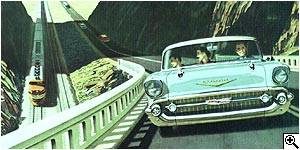 If ever a car captured a nation’s mood, it was the ’57 Chevy Bel Air. In an era of rock’n’roll, this Bel Air was one sweet Chevy.
If ever a car captured a nation’s mood, it was the ’57 Chevy Bel Air. In an era of rock’n’roll, this Bel Air was one sweet Chevy.
Unlike that year’s Ford and Plymouth, the ’57 Chevrolet was not an all-new car. But it would never be confused with the Chevys that came before it.
Up front, jet aircraft-inspired intake pods contained the headlamps, and a new integral bumper/grille assembly served up a new level of elegance.
Gold-toned hood and trunk “vee”s (on V8 models), and front-fender ornamentation added “big-car” style.
Out back, it was the Cadillac-like tailfins and the sweeping rear-quarter panel aluminum trim panel that just seemed so right. Any way you looked at it, the ’57 Bel Air had it all.
Under the hood, there was big news, too. A revolutionary Ramjet Fuel Injection system was the ultimate V8 performance option on all ’57 Chevys and Corvettes. But even the regular 265- and 283-cubic-inch V8 engines delivered performance that put Chevy at the head of the class in 1957.
The ’57 Bel Air was a favorite on the showroom floor. But the real story behind this American classic is its enduring popularity. Because of its youthful style, easily hot-rodded V8 and rugged dependability, the ’57 quickly became one of the most sought-after used cars in history.
And talk about staying power. Today, this symbol of a more carefree era remains one of the most recognized, most loved automobiles of all time.
THE 1960s CHEVY BEL AIR: A FAMILY FAVORITE IN THE WONDER YEARS.
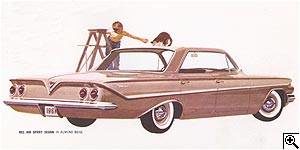 When the all-new, longer, lower and wider 1958 Chevrolet was unveiled, the 1955–57 Bel Airs instantly earned legendary status.
When the all-new, longer, lower and wider 1958 Chevrolet was unveiled, the 1955–57 Bel Airs instantly earned legendary status.
The big new Chevrolet’s were exactly right for their times (smooth-riding, luxurious and exceedingly good-looking), yet there’s no denying they were missing some of that “attitude” a whole generation of hot-rodders found so appealing in the “classic Chevy’s.”
The Bel Air series was demoted in ’58, replaced by the all-new Impala as the top-of-the-line Chevy.
The Six-passenger Bel Air sedans and 3-seat Bel Air wagons were just the thing for 1960’s-style family vacations and car pools.
The last Bel Air rolled off an American assembly line in 1975. By that time, Americans were choosing Impala and Caprice-style luxury in their full-size Chevys.
Those seeking economy were finding it in smaller cars, however the Bel Air is still sought after and enjoyed today. CLICK HERE

